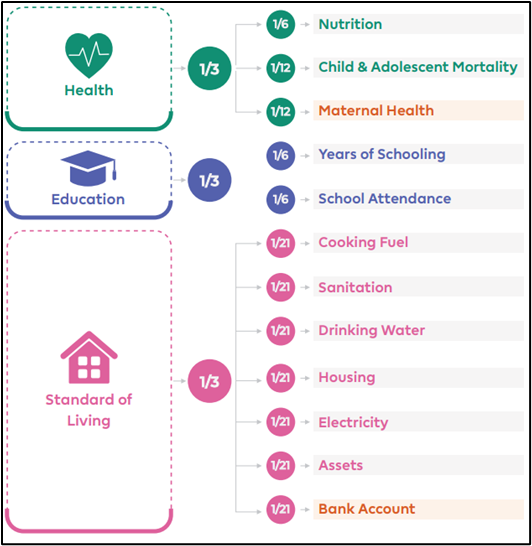Mains Daily Question
July 18, 2023
Elaborate on the factors contributing to Multidimensional Poverty in India and highlight the government policies and initiatives aimed at addressing this issue effectively.
Approach:
Introduction: Define Multidimensional Poverty and show the status of India w.r.t Multidimensional Poverty.
Body: Explain the factors with relevant examples and highlight the government policies and initiatives in this direction.
Conclusion: Give a way forward by explaining how these policies need to be implemented.
Answer:
Multidimensional poverty in India is a complex and pervasive issue that encompasses various dimensions of deprivation beyond income alone. The World Bank defines multidimensional poverty as a state of deprivation in several aspects of life, such as education, health, standard of living, access to basic services, and social inclusion. It is influenced by a multitude of factors that contribute to the deprivation of basic necessities and opportunities.
A record 13.5 crore people moved out of multidimensional poverty between 2015-16 and 2019-21 as per NITI Aayog’s Report ‘National Multidimensional Poverty Index: A Progress Review 2023’.
Indicators of MPI:
Key factors contributing to multidimensional poverty in India:
- Income Inequality: Income disparities in India are significant, with a large portion of the population living in poverty. This inequality exacerbates multidimensional poverty, as access to basic services and opportunities is limited for the poor.
- According to Oxfam, the richest 1% of the Indian population holds more than four times the wealth held by the bottom 70%.
- The Gini coefficient, a measure of income inequality, for India, is estimated to be around 0.35 (World Bank, 2021).
- Example: The distribution of wealth and income in Mumbai, India's financial capital, is highly skewed. The city has luxurious high-rise buildings alongside slums, highlighting stark income disparities.
- Education: Lack of access to quality education is a major contributor to multidimensional poverty. Illiteracy and low educational attainment hinder individuals from breaking the cycle of poverty and accessing better opportunities.
- According to the Annual Status of Education Report (ASER), in 2020, only 58% of rural children in the age group of 6-14 years could read at least a Grade 2 level text in their own language.
- Dropout rates are high, especially among girls and marginalized communities.
- Healthcare accessibility and cost: Limited access to healthcare services, particularly in rural areas, leads to poor health outcomes and contributes to multidimensional poverty. High healthcare costs, inadequate infrastructure, and low-quality healthcare facilities further exacerbate the problem.
- The World Bank estimates that 60% of India's healthcare expenditure is out-of-pocket, which can push households into poverty.
- Rural areas face a shortage of healthcare facilities and skilled healthcare professionals.
- Sanitation and Clean Water: Lack of access to clean drinking water and proper sanitation facilities is a significant issue in India. Poor sanitation and contaminated water sources contribute to the spread of diseases, impacting the overall well-being of individuals and perpetuating multidimensional poverty.
- According to UNICEF, in 2021, around 40% of the Indian population lacked access to basic sanitation facilities.
- Unsafe drinking water sources contribute to waterborne diseases, affecting the health of individuals.
- Housing and Infrastructure: Many people in India lack access to adequate housing and basic infrastructure such as electricity, sanitation, and transportation. Inadequate housing conditions and lack of essential services further entrench individuals in poverty.
- According to the Census of India 2011, around 17% of urban households live in slums, lacking basic amenities.
- Limited access to electricity, proper roads, and transportation hinders economic opportunities.
To address multidimensional poverty effectively, the Indian government has implemented several policies and initiatives:
- Mahatma Gandhi National Rural Employment Guarantee Act (MGNREGA): This scheme provides a legal guarantee of at least 100 days of wage employment per year to rural households. It aims to enhance livelihood security and reduce poverty by creating employment opportunities.
- Pradhan Mantri Jan Dhan Yojana (PMJDY): This initiative promotes financial inclusion by providing access to banking services and financial literacy to the poor. It aims to enable them to save, access credit, and receive government subsidies directly, reducing vulnerability to poverty.
- Pradhan Mantri Ujjwala Yojana (PMUY): This scheme aims to provide clean cooking fuel to women below the poverty line by offering subsidized LPG connections. It helps reduce indoor air pollution caused by traditional cooking fuels and improves health outcomes.
- Swachh Bharat Abhiyan (Clean India Mission): This campaign focuses on improving sanitation and hygiene practices across the country. It aims to eliminate open defecation, construct toilets, and promote proper waste management to enhance public health and reduce poverty-related diseases.
- National Rural Health Mission (NRHM): This program aims to provide accessible, affordable, and quality healthcare services to rural populations. It focuses on improving infrastructure, training healthcare professionals, and ensuring the availability of essential drugs and diagnostics.
- Pradhan Mantri Awas Yojana (PMAY): This initiative seeks to provide affordable housing for all by 2022. It targets both urban and rural areas, aiming to address the housing needs of the economically weaker sections and low-income groups.
- Skill India Mission: This program focuses on skill development and vocational training to enhance employability and income-earning opportunities. It aims to equip individuals with relevant skills to break the cycle of poverty and improve their socio-economic status.
By addressing the underlying factors contributing to multidimensional poverty, the government strives to create a more inclusive and prosperous society for all its citizens. However, continuous monitoring, evaluation, and targeted interventions are crucial for sustainable and long-term impact in reducing multidimensional poverty in India.


